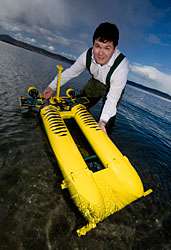Introducing Tassie's underwater robot – 'Searise'

A miniature CSIRO submarine being used to study the health of Tasmania’s waterways has officially been named ‘Searise’.
A year-two student from Burnie Primary School, Jacob Wise, made the winning suggestion in a competition run by CSIRO Education and CSIRO’s Tasmanian ICT Centre. Entries were judged by an independent panel of experts including a children’s author and a teacher.
“I called the robot Searise because of climate change in Antarctica,” Jacob said in his entry. “If Antarctica melts the sea will rise because of all the water.”
There was also a colouring-in competition, which was won by Laurence McMahon, a year-six student from Albeura St Primary School in the Hobart suburb of Sandy Bay. Laurence will receive his prize during today’s launch of the Tasmanian node of CSIRO’s ICT Centre.
“We received 217 entries for the naming competition and 438 entries for the colouring-in competition from all over the state,” said CSIRO autonomous vehicles expert, Dr Paulo de Souza. “We hope that, by stimulating students to think about science and technology in this way, we are motivating and inspiring the next generation of scientists.”
Searise is one of the 'Starbug' submarine robots developed by the CSIRO ICT Centre in Queensland, which are mostly used to monitor and survey underwater ecosystems.
The autonomous underwater vehicles are not remotely controlled: the only help they need is general operating commands.
In Tasmania, Searise will begin working on a project monitoring the health of the Derwent and Huon estuaries and the D'Entrecasteaux channel.
A network of sensors on the sea floor is already monitoring environmental variables such as salinity, temperature, turbidity and amount of phytoplankton. The aim of this work is to explore the sustainable multiple uses of the region for industry, recreation, environmental and aquaculture.
Searise is being fitted with sensors so it can take measurements between moored nodes and will soon be fitted with special imaging equipment so it can classify the seafloor habitats as, for example, a seagrass bed, sand or silt.
Provided by CSIRO




















